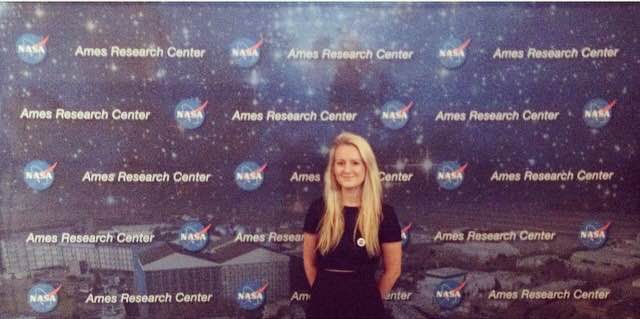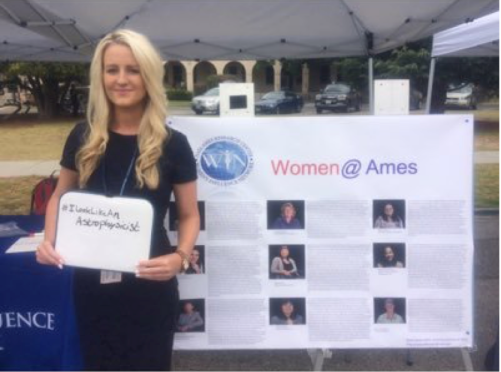mckeowla@tcd.ie
I am a third year Ph.D. student and member of the Trinity College Dublin Earth and Planetary Surface Processes Group. I am interested in planetary cryospheric science and surface processes on icy planetary objects. I graduated with a first class honors degree in Physics with Astronomy and Space Science from University College Dublin and am now unifying my long – time interest in planetary science with my background in physics. My project is entitled An Investigation of the Role of Carbon Dioxide Sublimation as a Geomorphic Agent on Mars, and I am funded by an Irish Research Council Government of Ireland Postgraduate Scholarship.

#LoveIrishResearch Campaign: Lauren (second from the right) with other Irish Research Council – funded students. Third from left: Chair of the Irish Research Council; Prof. Jane Ohlmeyer, Minister of State for Skills, Research and Innovation; Damien English and Director of the Irish Research Council; Dr. Eucharia Meehan.
The Martian atmosphere is comprised of over 95% carbon dioxide, and yet we still do not know to what extent this dominant volatile interacts with Mars’ surface in the present day. While current atmospheric conditions on Mars are not conducive to the sustainability of liquid water without the presence of salts, phase changes of CO2 are believed to play a significant role in the formation of features such as Martian gullies, ‘Swiss cheese’ terrain, furrows and spiders, among others. My project aims to investigate whether CO2 may form linear gullies – a sub type of Martian gullies that populate dunes in the southern hemisphere and are characterized by small alcoves, narrow channels, levées and terminal pits. In particular, I want to understand the likely mechanisms responsible for terminal pit formation, because we have no earth analogues for these features. I spend a lot of time in the lab placing CO2 ice blocks on sand beds and analyzing the morphologies produced. I also enjoy exploring high-resolution images of the Martian surface, to observe new features or assign geographical trends to existing ones.

Linear gullies on Russell Crater Megadune. These gullies are distinguished from classic ACA (Alcove – Channel – Apron) gullies which are also found on Earth, by their terminal circular depressions or ‘pits’. These replace the aprons typically associated with wet debris – flow processes. Multiple smaller detached pits surround many linear gully main terminal pits. Image: NASA/JPL/University of Arizona.
I am from Dublin – born and bred, but I have travelled a lot for my work. A huge highlight for me so far in my career was being selected by the Irish Research Council in 2015 to complete a summer internship at NASA Ames. During this internship, I worked with other interns in a Space Biosciences Dept. group to investigate new ways to facilitate long-haul space travel to Mars.

Summer Internship at NASA Ames: Lauren during her internship at Ames, attending the New Horizons Pluto Flyby event.
My ultimate goal after my Ph.D. is to return to Ames or NASA JPL to conduct further research in my field and then to return home to Ireland to share this connection with graduate students and expand the small (but growing!) planetary science community here. If you haven’t guessed already – I’m ambitious and think ahead 🙂 When not doing that, I enjoy art, writing creatively and working on my on/off relationship with the gym. Outreach is very important to me and I try to contribute to the visibility of women in science by visiting schools and telling young students about my research and my interests. I believe science does not have a uniform and I am passionate about eradicating stereotypes in STEM.
 “Hello Earthlings”: Lauren skyping the Assumption Junior School to answer any questions the future of science had on “All Things Space”.
“Hello Earthlings”: Lauren skyping the Assumption Junior School to answer any questions the future of science had on “All Things Space”.

Diversity at NASA Ames: Lauren, pictured at the Women @ Ames stand, supporting a field without stereotypes.
Leave a comment